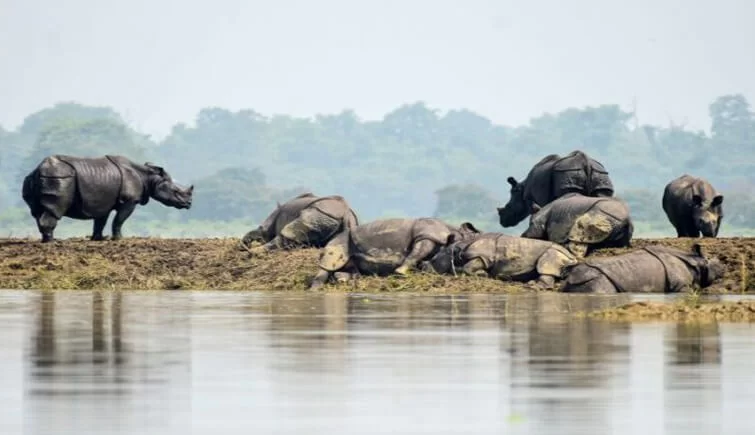The state of Assam has once again found itself in the throes of a severe flood crisis, with the situation particularly dire in the upper regions of the state. Incessant rainfall and overflowing rivers have submerged thousands of homes, displaced hundreds of thousands, and claimed numerous lives, leaving the affected communities in a state of despair.
According to the Assam State Disaster Management Authority (ASDMA), over 6.44 lakh people have been affected by the floods across 19 districts as of Monday, July 1st. The hardest-hit areas are the upper Assam districts of Lakhimpur and Dhemaji, where the deluge has impacted 1.43 lakh and 1.01 lakh people, respectively.
The relentless downpour has caused several major rivers, including the Brahmaputra, Desang, Subansiri, Dekhow, Buridehing, Beki, and Barak, to flow above the danger mark, leading to widespread inundation. The situation has been further exacerbated by the release of excess water from the Subansiri Lower Dam, which has submerged 11,000 people in 21 villages of the North Lakhimpur district.
The flooding has displaced thousands of people and taken a heavy toll on the region’s infrastructure. Roads and bridges have been washed away, disrupting connectivity and hampering rescue and relief efforts. The Kurung Bridge, a crucial link connecting the frontier areas bordering China, has been destroyed, further isolating these remote communities.
The impact on the Kaziranga National Park, a UNESCO World Heritage Site, has been devastating. As many as 95 out of the 233 forest checkposts have been inundated, triggering the migration of wild animals to the neighboring Karbi Anglong hills.

The flood has taken a heavy toll on the park’s wildlife, particularly the one-horned rhinoceros. According to information released by park authorities almost 200 animals, including 17 one-horned rhinoceros, have died in these floods. The hog deer have been the most affected, with 124 of them losing their lives either by drowning or being killed while crossing the NH-37.
Other casualties include 17 wild boars, 13 sambhars, a porcupine, and an elephant. The rapid current of the flood has washed away many animals, especially smaller ones like deer, while others have died due to drowning or starvation.
The flooding has also disrupted the animals’ natural habitats, leading to increased sightings of them near human settlements and roadways. Disturbing images have emerged of exhausted rhinos lying on stretches of land after wading through deep waters, and a tiger seeking refuge in a house near the national highway.
In the face of this calamity, the state government has swung into action, deploying the National Disaster Response Force (NDRF) and the Indian Army to assist in rescue and relief operations. Temporary relief camps have been set up across the affected districts, providing shelter and essential supplies to the displaced populations.
The Brahmaputra River in Assam has seen a significant rise in water levels
However, the situation remains critical, with the India Meteorological Department (IMD) issuing a ‘red warning” for the Northeast states, predicting very heavy to extremely heavy rainfall from July 2nd to July 5th. Chief Minister Himanta Biswa Sarma has acknowledged the gravity of the situation, stating that the next 3-4 days will be “very critical” for Assam.
The flood crisis in Assam’s upper regions is a stark reminder of the increasing frequency and intensity of natural disasters driven by climate change. As the state grapples with the immediate challenges of rescue, relief, and rehabilitation, it must also address the long-term implications of this crisis and invest in comprehensive disaster management strategies to mitigate the impact of future floods.
The people of Assam have shown remarkable resilience in the face of these recurring calamities, but the burden they bear is heavy. It is the responsibility of the state and central governments, as well as the international community, to provide the necessary support and resources to help these communities rebuild their lives and livelihoods.
In the aftermath of this devastating flood, the people of Assam will need sustained assistance and long-term solutions to ensure that they can withstand the increasing frequency and intensity of natural disasters. Only through a concerted and coordinated effort can we ensure that the resilience of these communities is strengthened, and their future is secured in the face of the ever-changing climate.











One thought on “Floods: Assam Upper Regions Grapple with Devastating Floods”